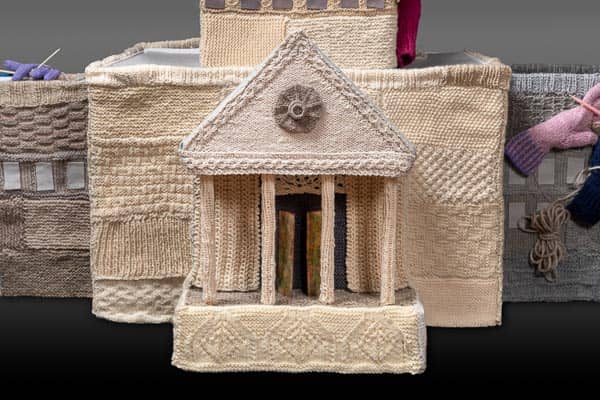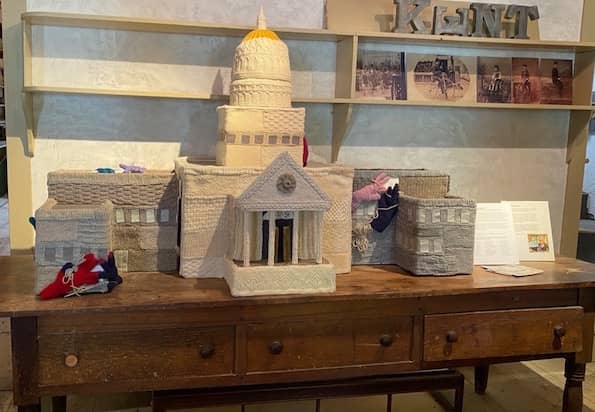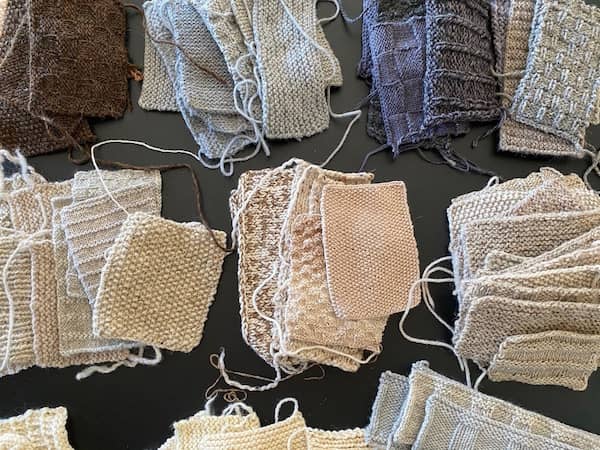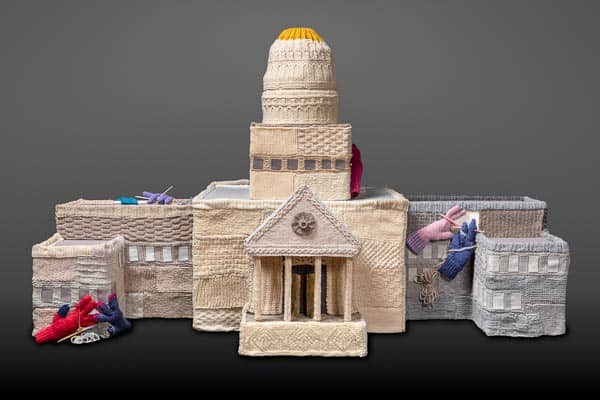Until 1997, I thought knitting was just for clothing. Like most people, I considered knitting a domestic handcraft. My perception changed when I stumbled on the art of Katharine Cobey. She was knitting large scale sculptures and installations addressing serious issues: homelessness, aging, the Gulf Wars. When I realized I could use knitting to make art, I felt liberated.
I exhibited my knitted artwork for the first time in 2002. That experience brought a new reaction. Explaining how I made my artwork, I felt apologetic about the fact that I use yarn, rather than stone, to make sculpture. I confessed that I used knitting because I was proficient at it. Inside my head, I was apologizing for my lack of formal art training. It’s not that I had no training; it was simply a different kind. I had learned to knit from my mother, learned to spin yarn from a craftsperson, and deepened both these skills through numerous workshops organized by fiber guilds. These methods of learning are particularly oriented toward women.

I think knitting bears an extra burden. It was used exclusively for clothing, and women were mainly responsible for clothing production in the home. In contrast, tapestry weaving has been valued as fine art since the Middle Ages. European kings hung huge tapestries on castle walls telling grand stories. Knitting is the last textile technique to move from the home into the public sphere.
Embracing the domestic attributes of knitting in artwork
I no longer apologize for using a domestic handcraft in my work. I have embraced the feminine attributes of knitting. Its connection to the home makes it approachable, removing some of the barriers that might deter people from engaging with the subjects of my artwork. This is particularly true in my collaborative sculpture Knit Democracy Together.

Knit Democracy Together, detail of portico with enamel doors made by Beverly Shevis and medallion by Rachel Kahn, photo by Paul Rogers, Stowe, VT © 2021 Eve Jacobs-Carnahan
The process of making this sculpture borrows from traditional female ways of working. I designed and built the armature, but I invited other people to gather with me to knit, crochet, and stitch the pieces of the sculpture. These maker circles derive from the historical models of knitting and sewing circles. Like the knitting circles that supported the abolitionist and suffrage movements, Knit Democracy Together circles foster conversation about democracy.
I took the knitted pieces created at five maker circles and assembled them into a sculpture based on the Vermont State House. The sculpture went on display for the first time in September 2021 at Art at the Kent in Calais, Vermont. There all the makers were named and recognized on the informative panel accompanying the sculpture.

Knit Democracy Together, on display at Art at the Kent, Calais, VT, Sept. 10- October 11, 2021 © 2021 Eve Jacobs-Carnahan
The reaction of these makers to seeing their work on exhibit has been enlightening. It parallels my responses to discovering knitting as an art form. When they sent me their little pieces, many of the makers wrote notes apologizing for the imperfections in their knitting. But once they saw the finished sculpture, they beamed with pride. They told me how pleased they were to see their swatch become part of the whole.

Knitted building block pieces (roughly 4 x 6 inches) made by participants throughout Vermont during Knit Democracy Together knitting circles
This sculpture of a state capitol made by many hands carries extra significance. It underscores the symbolism of the knitted gloves on the sculpture working together for the common good. The movement of knitting from the domestic to the public sphere operates on several levels. On the simplest level, it brings knitting and women’s art out in public for all to see and appreciate. It also recognizes that hands of those who clothe the family can play a critical role in caring for democracy.

Knit Democracy Together, detail of dome made by Abby Colihan, photo by Paul Rogers, Stowe, VT © 2021 Eve Jacobs-Carnahan
To find out how this project got started and see an early maquette of the state capitol, check out my post from February 2020. I also wrote about historical knitting circles as precursors to today’s craftivist movement in my October 2020 post.
I am planning more knitting circles in 2022 and 2023. Learn more on the project website: knitdemocracy.org.

Love seeing the details here. Such a wonderul, community oriented and beautiful project. Glad it is getting out in the world!
❤️💙